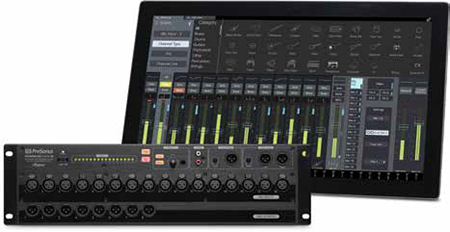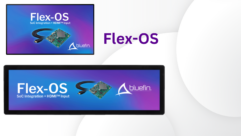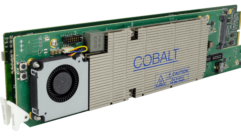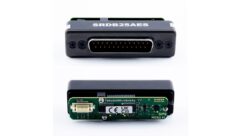

In the future, we’ll look back at 2014 and 2015 as the time when mixer control exclusively by computer or tablet first arrived on Planet Earth. But wait—we’ve had the capacity to control mixers remotely with laptops for eons now! But those mixers have sported faders and knobs—the remote control was in addition to, not a replacement for, the physical controls we love to tweak. Mixers controlled exclusively by computer or tablet have only come about recently. This leads me to predict a paradigm shift: in 2015, computers and tablets are secondary controllers, but by 2020-2025 they will become our primary controllers.
PreSonus has introduced its StudioLive RM series of network-controlled mixers, and considering the popularity of their traditional digital mixers, there’s no surprise that this foray out to the leading edge has gone over well and has emerged as another PreSonus success story.
PreSonus’ RM series consists of the RM16AI and RM32AI, and the model numbers indicate the complement of analog inputs featured by each. The unit sent to me for evaluation was the RM16AI. The RM32AI has twice as many analog inputs and outputs, but is otherwise essentially identical. The RM16AI’s physical hardware is contained in a three rack-space enclosure, and PreSonus parts with the familiar “controls up front/connections in the back” convention here, placing nearly everything on the front panel. The solitary control found on the RM16AI’s rear panel is the power switch, and the rear panel I/O connections also are sparse, with only the AC power inlet, MIDI in and out ports, DB25 analog output connectors (which mirror the front panel XLR outputs), and whatever is featured on the face of the digital option-card inhabiting the unit’s available slot. My evaluation unit was loaded with a FireWire 800 card, and all RM series mixers now ship stock with an AVB card, which includes FireWire 800 and facilitates the use of RM-series units as monitor mixers when using a traditional PreSonus StudioLive mixer. Cards are planned for Thunderbolt and Dante, as well.
The front panel is very I/O-centric, with 16 XLR mic inputs, each corresponding to a recallable XMAX Class-A preamp. There are eight XLR mix outputs, mono and stereo XLR main outputs with level knobs, a stereo RCA tape input, and a ¼in. headphone jack with a level knob and pushbuttons to determine signal source. The main and mono outputs can be set up to mix in L-C-R mode. Sixteen multi-color LEDs indicate signal presence, clipping, and phantom power status for each channel. A “meters +48V” pushbutton illuminates in yellow the LEDs corresponding to any channel with phantom power engaged. Any other time, green indicates signal present and red indicates clipping. A “mute all” button mutes every channel when pressed—handy for a feedback panic situation. A bi-color (blue/red) LED indicates system power, network, and firmware updating status. The only other feature on the front panel is a USB-A port, which would typically be used for the USB Wi-Fi LAN adapter included with the mixer, but also facilitates firmware updates.
Internally, both the RM16AI and RM32AI feature 32 mix channels. Combining the unit’s analog I/O with its FireWire digital I/O yields a total of 52 inputs and 34 outputs. There are 25 mix buses total: 16 auxiliary buses, three main buses, four internal effects buses, and a stereo solo bus. Each mix channel and aux bus features dual Fat Channel DSP, including polarity inversion, a gate/expander (which can be keyed), compressor, limiter, and equalizer (adjustable high-pass filter, low and high shelving, two parametric mids). I found every parameter of these processors to be very easy to access and adjust—the UC Surface graphical user interface is clear and simple.
The RM series isn’t PreSonus’ first rodeo, and among the various domains they’ve conquered over the years, digital signal processing is very notable. Their renowned Fat Channel has put smiles on the faces of many engineers, musicians, and venue owners, and it appears yet again in the RM series, living up to its name, delivering a fat warmth that is truly pleasing to the ear. The system’s default sample rate is 48kHz, but operation up to 96kHz is available. The gate/expander is easy to use, even for keyed operation. The compressor is versatile with auto attack and release for quick set-up, or manual settings to aid in the creation of a wider range of compression styles, from subtle to aggressive. The channel EQ sounds marvelous—truly an excellent digital incarnation of analog audio quality. The first 12 mix buses, the main bus, and the mono buses also feature 31-band graphic EQs enabling boost or cut of up to 12dB. The effects are very good too, with a broad spate of reverbs and delays from which to choose. My only request in terms of DSP would be the capacity to host third-party plug-ins internally. Clearly, this prospect would increase the price of this product in a moderately substantial way, but perhaps it could be offered as an option (and one that would clearly distinguish PreSonus from the other manufacturers of mixers similar to the RM series).
The UC Surface application controls the RM series mixers, and is available on Mac, Windows, and iPad. Mixing with a Windows 8 touchscreen is a singularly fabulous experience, but mixing with a laptop or even an iPad is also a joy. The app is well laid-out, and very intuitive. It consolidates the entire mixer to a single display, so there’s no digging through pages or layers to get where you want to go. It furnishes quick access to all parameters with no menu-diving. In particular, I was very pleased with how easy auxes and effects are to pull up. It employs a clever scrolling mechanism to move left to right or vice versa through the channels—almost as if sliding from one end of a large-format console to the other in a rolling chair. Active metering of 32 channels is permanent at the bottom of the display, whether the mixer or settings menu is selected. The entire system is compatible with PreSonus’ QMix-AI “more me” personal monitor control app, which is a free download. It’s a true joy to turn musicians loose with their own controls to create their own mixes. One suggestion I’d proffer is to open up a palette of colors in the application. The existing color scheme is clear and readable, but customization would be welcome—there are venues in which a more vivid display would be preferable, and some applications in which discreet, subtle tones would be better. And a handful of presets would be nice too—a good place to start when dialing up a color scheme to suit the application.
The RM16AI system was very easy for me to set up and use. I unboxed the unit in my test kitchen, applied AC power, and as I do when testing any mixer, plugged a pre-recorded multi-track source (courtesy of a DAW) directly into the unit’s analog inputs. I set up the Windows 8 Sony VAIO touchscreen computer that was included as part of the evaluation package, and within minutes, I had the GUI on the touchscreen and the LEDs on the front panel of the hardware unit all dancing. I was able to dial up a rough mix quite quickly, and with a bit of refinement over the next 20-30 minutes, had the sound I was looking for and a snapshot of the mix so I could recall it later. The network setup is not complicated, and mixing with a computer has become at least somewhat familiar to most of us in recent years. I suppose I need to just come right out and say it: Using a touch surface to mix is just plain fun—a true joy. And the quality of a mix is going to improve by virtue of the capacity to easily walk around a venue and hear what various tweaks are doing away from the FOH location.
The PreSonus RM series digital mixers represent a remarkable advancement in the way we do mixing, but they’re not so complex and advanced as to be challenging or difficult. They hold the hand of the user through the process of moving beyond knob-and-fader mixing to the touchscreen, and that development is very welcome. PreSonus’ audio quality is still excellent—as always—and the pricing is very reasonable, even considering that the user must provide the computer or tablet control device. The touchscreen paradigm shift is happening, and if you’re prepared to jump in, the PreSonus RM series is the smart way to do it.
John McJunkin is the founding manager of Avalon Podcasting, LLC, and produces video for a variety of clients. He has consulted in the development of studios and installations and provides high-quality podcast and voice production services.
PRODUCT SUMMARY
COMPANY: PreSonus | www.presonus.com
PRODUCT: StudioLive RM16AI Digital Mixer
PROS: Mixing from any location, high-quality audio, recording/playback via network
CONS: No user control over GUI color scheme, no internal support for third-party DSP plug-ins
APPLICATIONS: Network-controlled mixer for live sound, recording, broadcast, etc.
PRICE: $1,999.95 (RM32AI); $1,399.95 (RM16AI)
SPECIFICATIONS
MICROPHONE PREAMPS
• Frequency Response to Main Output (unity gain): 20-20kHz, ±0.5dBu
• Input Impedance: 1kΩ
• THD to Main Output (1kHz, unity gain): 0.005% (+4dBu, 20-20kHz, unity gain, unwtd)
• S/N to Main Output (Ref =+4dB, 20kHz, unity gain, A-wtd): 94dB
• Common Mode Rejection Ratio (1kHz, unity gain): 65dB
• Gain Control Range (±1dB): 0dB to +65dB
• Maximum Input Level (unity gain): +22dB
• Phantom Power (±2VDC, switchable per channel): 48VDC
• Main Outputs
• Rated Output Level: +24dB
• Output Impedance: 100Ω
HEADPHONE OUTPUT
• Maximum Output: 120mW/ch. @ 60Ω load
• Frequency Response: 20Hz–20kHz (± 0.5dB)
• THD+N (1kHz, max gain, 20Hz BW, unwtd): 0.01%
• S/N Ratio (1kHz, max gain, 20Hz BW, unwtd.): 96dB
• System Crosstalk
• Input to Output (Ref = +4 dBu 20 Hz-20 kHz, unwtd): -90dB
• Adjacent Channels (Ref = +4 dBu 20 Hz-20 kHz, unwtd): -87dB










